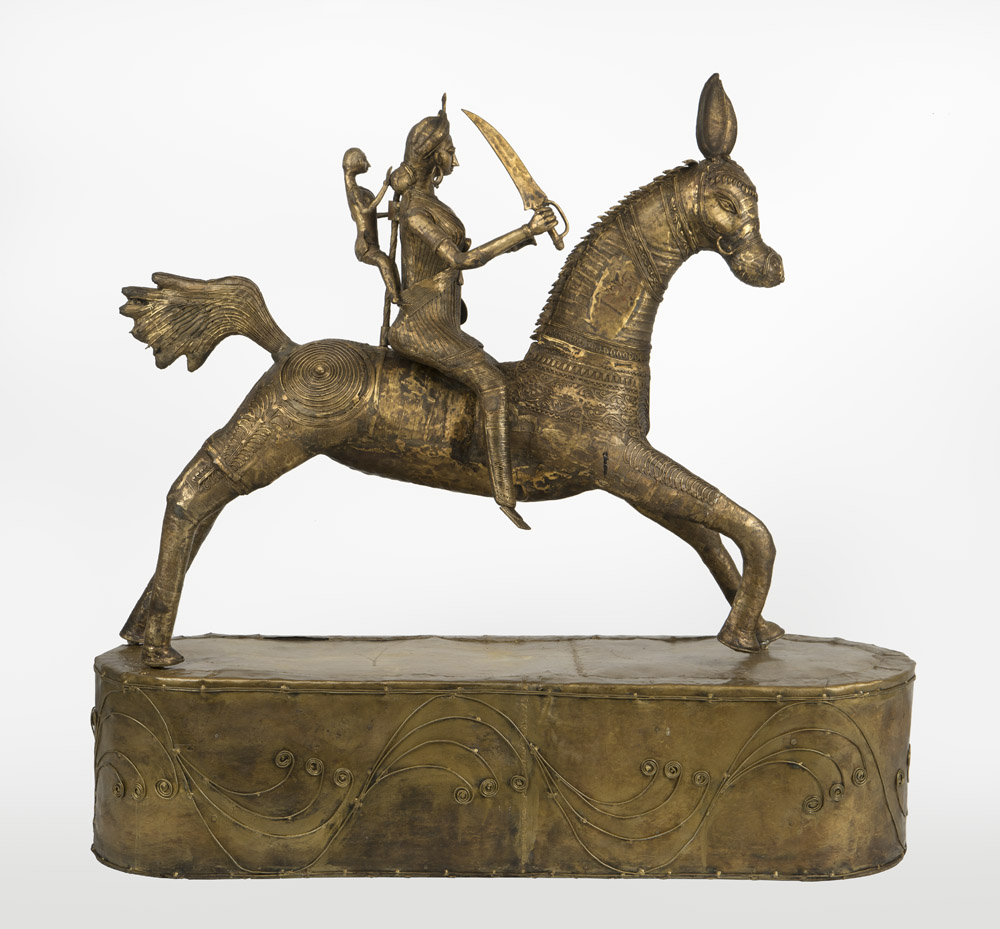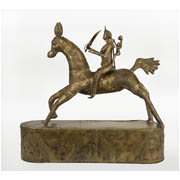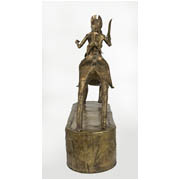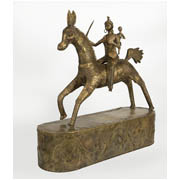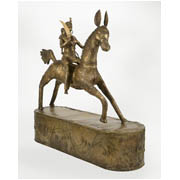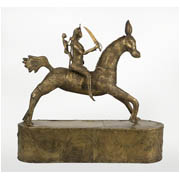Details
- Object type
dhokra sculpture
- Title
Rani of Jhansi
- Artist/Maker
Ramu Karmakar maker
Shubho Karmakar maker
- Culture/School
Dhokra Damar
- Place Associated
Asia, South Asia, India, West Bengal, Dariapur (place of manufacture)
- Date
2013
- Materials
brass alloy
- Dimensions
overall: 1423 mm x 1219 mm x 457 mm
- Description
-
This dhokra brass alloy sculpture of the 'Rani of Jhansi' by father and son artists Ramu and Shubho Karmakar from West Bengal depicts the armoured warrior queen Rani Lakshmi Bai (d.1858) of Jhansi, astride a horse, carrying an upraised sword in her right hand, a round shield on her arm left and with her adopted infant son Damodar Rao on her back. Lakshmi Bai, the Rani of Jhansi was an Indian queen and warrior. She was one of the leaders of the Indian Rebellion of 1857 and for Indian nationalists a symbol of resistance to the rule of the British East India Company in India. Lakshmi Bai was born on November 19th 1828 in Varanasi. In 1842, she married the Maharaja of Jhansi, Raja Gangadhar Rao. Following the death of their infant son in 1851, the Raja and Lakshmi Bai adopted the son of Gangadhar Rao’s cousin, who they named Damodar Rao. Following the death of the Raja in November 1853, the British, under Governor General Lord Dalhousie stated that they would not recognize the adopted child as the legal heir of the Raja and would hence annex Jhansi to British territory. The British seized the state jewels of Jhansi and expelled Lakshmi Bai from the palace and fort. Lakshmi Bai was determined to protect Jhansi from British annexation and formed an army of both men and women who were given military training. During the Indian First War of Independence Lakshmi Bai refused to surrender and tried to defend Jhansi from the British. The British bombarded the Jhansi fort, but were met with heavy fire in return but when Lakshmi Bai realized that resistance in Jhansi by her militia was futile, she decided to leave Jhansi and join forces with the main rebel army. Lakshmi Bai, along with her son Damodar Rao, escaped from Jhansi and joined forces with the resistance. On June 17th 1858 near Phool Bagh in Gwalior, British troops fought Indian forces commanded by Lakshmi Bai. Sorely outnumbered, Lakshmi Bai fought her way through enemy lines, her adopted son tied to her back, a sword in each hand and the reins of the horse in her mouth. She was fatally wounded but managed to ride to a secluded place where she handed her son to a trusted general. Three days after the death of Lakshmi Bai, the British captured the Fort of Gwalior.
- Credit Line/Donor
Acquired through the Art Fund’s RENEW programme with the support of the Esmée Fairbairn Foundation
- ID Number
A.2013.38
- Location
Kelvingrove Glasgow's Great Exhibitions
